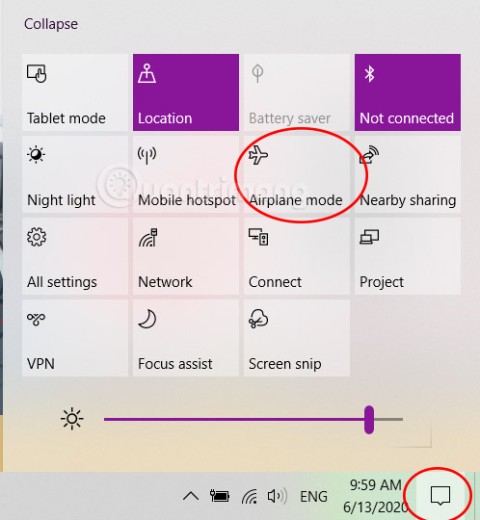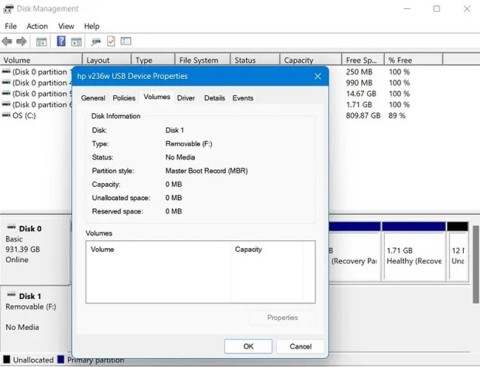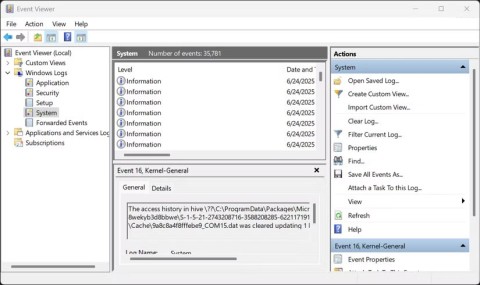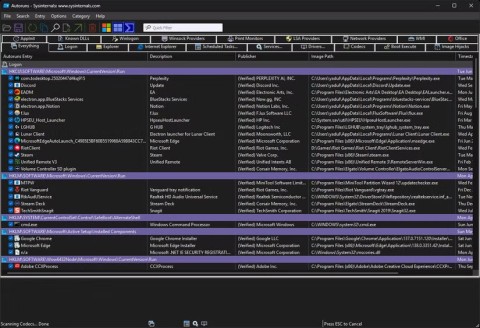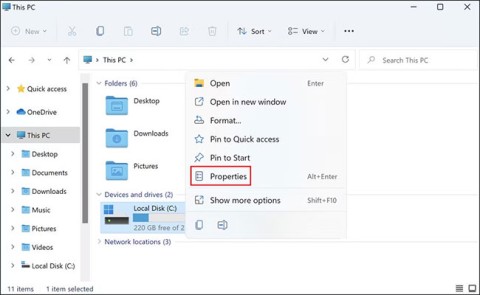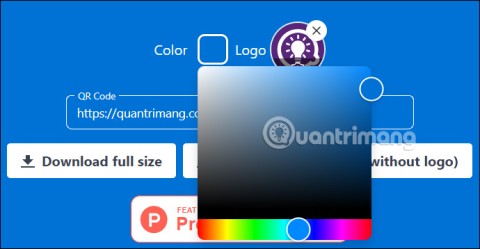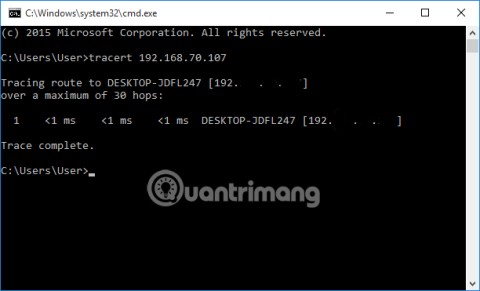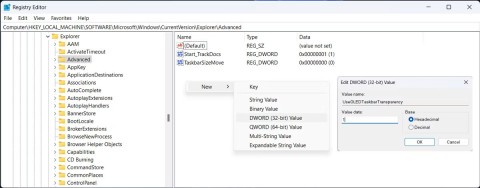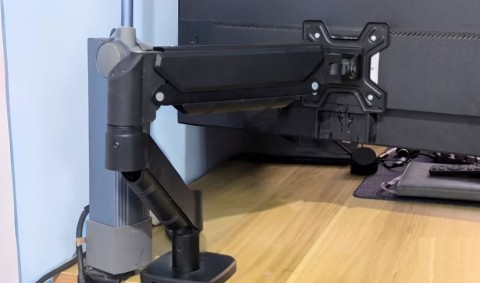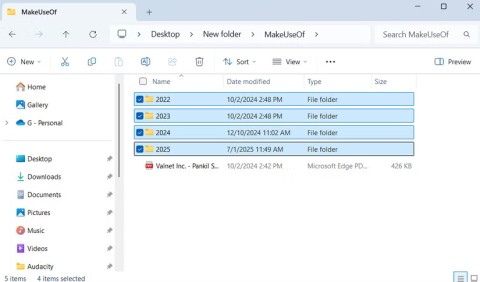Операційні системи — це рятівний круг будь-якого ПК, оскільки без них було б неможливо надсилати електронні листи, дивитися відео про котів або спілкуватися з нашими друзями. Але час від часу кожна операційна система стикається з такими проблемами, як повільне завантаження, аварійне завершення роботи додатків, збійний дисплей, хиткий звук тощо.
Якщо ви відчуваєте, що останнім часом ваша копія Windows 11 також поводиться дивно, ми вважаємо, що настав час взяти справу у свої руки та відремонтувати Windows 11.
Тепер, перш ніж поспішати до найближчої техніки з ремонту ПК, давайте подивимося на численні доступні у вашому розпорядженні методи, які можуть допомогти вам відновити пошкоджену інсталяцію Windows 11.
Зміст
Спосіб №1. Використовуйте засіб усунення несправностей Windows
Засоби усунення несправностей Windows пройшли довгий шлях, і тепер вони можуть вирішити більшість ваших проблем простим клацанням миші. Більшість команд усунення несправностей і перевірок, які зазвичай виконувались за допомогою CMD і PowerShell, тепер включені в засоби усунення несправностей, що робить їх набагато зручнішими при виникненні проблем. Якщо ви все ще не можете виправити та відновити інсталяцію Windows 11, можливо, варто спробувати засіб усунення несправностей. Скористайтеся наведеним нижче посібником, щоб почати.
Натисніть Windows + iна клавіатурі, щоб відкрити програму Налаштування. Переконайтеся, що зліва вибрано «Система», а потім натисніть «Усунення неполадок» праворуч.
![Як відновити Windows 11 [15 способів] Як відновити Windows 11 [15 способів]](https://img2.webtech360.com/resources8/images31/image-6439-0105182722076.png)
Натисніть «Інші засоби усунення несправностей».
![Як відновити Windows 11 [15 способів] Як відновити Windows 11 [15 способів]](https://img2.webtech360.com/resources8/images31/image-405-0105182722143.png)
Тепер знайдіть відповідний засіб усунення несправностей для вашої поточної проблеми залежно від проблеми, яка виникла під час встановлення. Натисніть «Виконати» поруч із засобом усунення несправностей.
![Як відновити Windows 11 [15 способів] Як відновити Windows 11 [15 способів]](https://img2.webtech360.com/resources8/images31/image-9440-0105182722204.png)
Засіб усунення несправностей тепер зробить свою справу та виправить будь-які проблеми, які виявить із відповідним компонентом або функцією.
![Як відновити Windows 11 [15 способів] Як відновити Windows 11 [15 способів]](https://img2.webtech360.com/resources8/images31/image-9235-0105182955896.png)
Спосіб №2. Видаліть та повторно встановіть усі останні оновлення Windows
Якщо ви зіткнулися з випадковими збоями, низькою продуктивністю, тремтінням або помилками раптово після останнього оновлення Windows, ви можете спробувати видалити останні оновлення, щоб вирішити свою проблему. Ці оновлення слід відновити за допомогою відновлення системи за допомогою керівництва вгорі, але якщо у вас немає точки відновлення, ви можете скористатися наведеним нижче посібником, щоб вручну видалити оновлення Windows зі своєї системи Windows 11.
Натисніть Windows + iна клавіатурі, щоб відкрити програму Налаштування. Тепер натисніть на Windows Update зліва.
![Як відновити Windows 11 [15 способів] Як відновити Windows 11 [15 способів]](https://img2.webtech360.com/resources8/images31/image-6752-0105182955965.png)
Натисніть «Оновити історію».
![Як відновити Windows 11 [15 способів] Як відновити Windows 11 [15 способів]](https://img2.webtech360.com/resources8/images31/image-9408-0105182722517.png)
Прокрутіть униз і натисніть «Видалити оновлення».
![Як відновити Windows 11 [15 способів] Як відновити Windows 11 [15 способів]](https://img2.webtech360.com/resources8/images31/image-1959-0105182722745.png)
Тепер ви потрапите на панель керування, де ви отримаєте список усіх останніх основних оновлень, встановлених у вашій системі. Ви не отримуватимете оновлень безпеки, зазначених у цьому списку, оскільки їх не можна видалити з міркувань безпеки. Натисніть і виберіть оновлення, яке потрібно видалити.
![Як відновити Windows 11 [15 способів] Як відновити Windows 11 [15 способів]](https://img2.webtech360.com/resources8/images31/image-3028-0105182722836.png)
Тепер натисніть «Видалити» вгорі.
![Як відновити Windows 11 [15 способів] Як відновити Windows 11 [15 способів]](https://img2.webtech360.com/resources8/images31/image-2165-0105182722899.png)
Примітка. Якщо ви не отримуєте опцію «Видалити», ймовірно, ви намагаєтеся видалити важливий компонент Windows, який порушить функціональність вашої поточної інсталяції.
Натисніть «Так», щоб підтвердити свій вибір.
![Як відновити Windows 11 [15 способів] Як відновити Windows 11 [15 способів]](https://img2.webtech360.com/resources8/images31/image-9581-0105182722985.png)
Тепер вибране оновлення буде видалено з вашої системи. Рекомендуємо перезавантажити систему та перевірити, чи вирішено проблему, з якою ви зіткнулися. Якщо ні, продовжуйте видаляти оновлення Windows, доки не знайдете винуватця.
Спосіб №3: Відновлення до старішої точки відновлення системи
Примітка. Цей метод передбачає, що у вас є функціональна копія Windows 11, яку можна завантажити.
Ви можете розглядати точки відновлення системи як шляхи відновлення системи до попереднього стану Windows (коли була створена точка відновлення) разом із програмами та налаштуваннями, які були на вашому комп’ютері на той час.
Windows 11 автоматично створює точки відновлення системи через регулярні проміжки часу. Якщо ви хочете, ви також можете створити точки відновлення.
Вони також створюються, коли інсталюється нова програма або оновлення Windows.
Ось як ви можете спробувати відновити Windows 11 за допомогою точок відновлення.
Відкрийте меню «Пуск» і введіть «Створити точку відновлення». Потім натисніть на параметр, показаний нижче.
![Як відновити Windows 11 [15 способів] Як відновити Windows 11 [15 способів]](https://img2.webtech360.com/resources8/images31/image-7098-0105182723056.png)
Тепер має бути відкрито спливаюче меню з назвою «Властивості системи», і ви зможете побачити параметри, пов’язані з відновленням системи, як показано нижче.
![Як відновити Windows 11 [15 способів] Як відновити Windows 11 [15 способів]](https://img2.webtech360.com/resources8/images31/image-1063-0105182723121.png)
Якщо ваше спливаюче меню виглядає так само, як наше з вимкненим параметром «Захист» для всіх ваших дисків, у нас для вас погані новини. Через відсутність попередніх точок відновлення системи немає сенсу продовжувати цей метод, оскільки немає точки відновлення, до якої можна було б повернутися.
На цьому етапі ми рекомендуємо спробувати наступний метод.
Порада: якщо ви читаєте це лише для того, щоб побачити, як усе працює, ми пропонуємо вам увімкнути захист для системного диска (виділено нижче), на якому міститься Windows 11, і створити точку відновлення прямо зараз.
![Як відновити Windows 11 [15 способів] Як відновити Windows 11 [15 способів]](https://img2.webtech360.com/resources8/images31/image-2132-0105182723214.png)
Ось як це можна зробити.
Виберіть диск з позначкою «Система» та натисніть «Налаштувати».
![Як відновити Windows 11 [15 способів] Як відновити Windows 11 [15 способів]](https://img2.webtech360.com/resources8/images31/image-6753-0105182723323.png)
Потім натисніть кнопку «Увімкнути захист системи» та виділіть місце для точок відновлення системи, пересуваючи повзунок нижче. Ми виділили лише 4% нашого системного диска, що близько 4,5 ГБ.
Якщо кількість або розмір точок відновлення збільшується, старі будуть автоматично видалені, щоб звільнити місце для нових.
Натисніть «Застосувати», а потім «ОК».
![Як відновити Windows 11 [15 способів] Як відновити Windows 11 [15 способів]](https://img2.webtech360.com/resources8/images31/image-2650-0105182723417.png)
На диску, який ви вибрали раніше, тепер має бути увімкнено «Захист», і тепер ви зможете створювати точки відновлення системи.
![Як відновити Windows 11 [15 способів] Як відновити Windows 11 [15 способів]](https://img2.webtech360.com/resources8/images31/image-3719-0105182723520.png)
Перебуваючи в тому ж спливаючому меню, натисніть кнопку «Створити», щоб створити першу точку відновлення системи на вашому ПК.
![Як відновити Windows 11 [15 способів] Як відновити Windows 11 [15 способів]](https://img2.webtech360.com/resources8/images31/image-7789-0105182723725.png)
Тепер має з’явитися спливаюче вікно із запитом про назву точки відновлення, не соромтеся вводити все, що забажаєте. Для вашої зручності поточний системний час і дані вашого ПК автоматично додаються, щоб цю точку відновлення можна було відрізнити від інших. Наразі ми вводимо «Нова інсталяція», оскільки нещодавно перевстановили Windows 11.
Після завершення натисніть «Створити».
![Як відновити Windows 11 [15 способів] Як відновити Windows 11 [15 способів]](https://img2.webtech360.com/resources8/images31/image-2823-0105182723892.png)
Через деякий час ваша точка відновлення повинна бути готова. Тепер ви зможете перевірити це, натиснувши кнопку «Відновлення системи».
![Як відновити Windows 11 [15 способів] Як відновити Windows 11 [15 способів]](https://img2.webtech360.com/resources8/images31/image-7821-0105182956057.png)
Натисніть Далі.
![Як відновити Windows 11 [15 способів] Як відновити Windows 11 [15 способів]](https://img2.webtech360.com/resources8/images31/image-7756-0105182724049.png)
І ваша новостворена точка відновлення системи має бути тут.
![Як відновити Windows 11 [15 способів] Як відновити Windows 11 [15 способів]](https://img2.webtech360.com/resources8/images31/image-6893-0105182724113.png)
Вибір точки відновлення та натискання (тоді ввімкненої) кнопки «Далі» призведе до відновлення ПК до моменту створення точки відновлення.
Спосіб №4: Використання інструменту командного рядка SFC
Перевірка системних файлів (SFC) і Обслуговування образів розгортання та керування ними (DISM) — це два інструменти командного рядка, які частіше використовуються ІТ-техніками в корпораціях для обслуговування машин Windows.
Якщо ви вперше чуєте про ці інструменти, то нема про що хвилюватися, оскільки вони, як правило, вважаються електроінструментами, і мало хто знає про них.
Давайте спочатку почнемо з SFC і подивимося, як ви можете відновити Windows 11.
SFC можна використовувати для сканування та перевірки захищених файлів (файлів Windows). Якщо він виявить, що файл пошкоджено і його неможливо перевірити, він намагається відновити нову копію з наведеної нижче папки на вашому ПК.
C:\Windows
Ось як ви можете спробувати цей варіант.
Натисніть кнопку «Пуск», введіть «командний рядок» і переконайтеся, що ви запустили програму від імені адміністратора, як зазначено нижче.
![Як відновити Windows 11 [15 способів] Як відновити Windows 11 [15 способів]](https://img2.webtech360.com/resources8/images31/image-8890-0105182956148.png)
У командному рядку введіть таку команду або просто скопіюйте та вставте її. Потім натисніть «Enter».
sfc /scannow
Вищенаведена команда миттєво запускає сканування, яке займає приблизно кілька хвилин для повної перевірки.
![Як відновити Windows 11 [15 способів] Як відновити Windows 11 [15 способів]](https://img2.webtech360.com/resources8/images31/image-4377-0105182724504.png)
Якщо сканування виявить, що всі ваші файли в хорошому стані, це буде показано нижче.
![Як відновити Windows 11 [15 способів] Як відновити Windows 11 [15 способів]](https://img2.webtech360.com/resources8/images31/image-5446-0105182724592.png)
Але якщо на вашому комп’ютері є пошкоджені файли Windows, SFC зможе виправити їх за допомогою нової копії.
Метод № 5: Використання інструмента командного рядка DISM
DISM — це ще один інструмент командного рядка, який набагато потужніший, ніж SFC. Він може працювати з кількома типами образів Windows 11 у форматах .wim і .esd, керувати драйверами перед розгортанням образів на ПК та багато іншого.
Давайте подивимося, як ви можете використовувати DISM для відновлення Windows 11.
Відкрийте командний рядок як адміністратор, використовуючи кроки, які ми щойно згадали для SFC.
Потім вставте наведену нижче команду, щоб перевірити установку Windows 11 на наявність помилок, і натисніть Enter.
Dism /Online /Cleanup-Image /ScanHealth
Ви повинні побачити щось подібне.
![Як відновити Windows 11 [15 способів] Як відновити Windows 11 [15 способів]](https://img2.webtech360.com/resources8/images31/image-5068-0105182725172.png)
Після завершення інструмент повинен повідомити про результати. Ось як виглядає наш екран.
![Як відновити Windows 11 [15 способів] Як відновити Windows 11 [15 способів]](https://img2.webtech360.com/resources8/images31/image-9689-0105182725280.png)
Потім запустіть цю команду, щоб перевірити, чи виявлено якісь проблеми та наскільки проблему можна виправити.
Dism /Online /Cleanup-Image /CheckHealth
Оскільки наш ПК працював нормально, вищезазначена команда не повідомляла про нульові проблеми. Ваш може бути іншим.
![Як відновити Windows 11 [15 способів] Як відновити Windows 11 [15 способів]](https://img2.webtech360.com/resources8/images31/image-3654-0105182725335.png)
Якщо DISM повідомив про проблеми з вашим ПК, наступна команда, яку ви повинні виконати, згадується нижче. Вставте його та натисніть «Enter».
DISM /Online /Cleanup-Image /RestoreHealth
Наведена вище команда запитує дійсні копії пошкоджених файлів із Windows Update. Ось як команда виглядає в дії.
![Як відновити Windows 11 [15 способів] Як відновити Windows 11 [15 способів]](https://img2.webtech360.com/resources8/images31/image-7724-0105182725565.png)
А ось як це виглядає після завершення обробки.
![Як відновити Windows 11 [15 способів] Як відновити Windows 11 [15 способів]](https://img2.webtech360.com/resources8/images31/image-9311-0105182725854.png)
Все, що вам потрібно зробити, це перезавантажити ПК.
Якщо ви вважаєте себе тим, хто розуміє інструменти командного рядка та їх параметри, і хочете дізнатися більше про SFC і DISM, а також про діапазон параметрів, які можна використовувати з ними, ось повна документація про SFC , а ось повна довідка. для DISM . Насолоджуйтесь інформацією!
Tip: If your Windows 11 processes crash often, restart a few seconds later and show an alert with a bunch of numbers and alphabets (aka error codes), we highly recommend putting them in a search engine like Google and understanding what they mean. This method of troubleshooting is extremely effective against specific errors and problems, and can often prove to be a lifesaver.
Method #6: Using Windows 11 Startup Repair
Windows 11 comes equipped with a built-in startup repair tool that is designed to detect and repair common startup problems you may be facing. Let’s take a look at how you can use Startup Repair to fix Windows 11.
Open the ‘Start’ menu and click on the ‘Power’ button.
![Як відновити Windows 11 [15 способів] Як відновити Windows 11 [15 способів]](https://img2.webtech360.com/resources8/images31/image-3277-0105182725914.png)
Hold the ‘Shift’ Key and click on ‘Restart’.
![Як відновити Windows 11 [15 способів] Як відновити Windows 11 [15 способів]](https://img2.webtech360.com/resources8/images31/image-794-0105182726004.png)
Your PC should boot into a blue screen with a bunch of options. Click on ‘Troubleshoot’.
![Як відновити Windows 11 [15 способів] Як відновити Windows 11 [15 способів]](https://img2.webtech360.com/resources8/images31/image-5932-0105182726311.jpg)
Click on ‘Advanced Options’.
![Як відновити Windows 11 [15 способів] Як відновити Windows 11 [15 способів]](https://img2.webtech360.com/resources8/images31/image-5382-0105182726417.jpg)
Click on ‘Startup Repair’.
Soon after, Windows should now be scanning and diagnosing your PC for any issues that may be preventing it from functioning properly. Let it work its magic and after some time, your copy of Windows 11 should be free of all the problems.
Tip: If ‘Startup Repair’ fails and you see the screen shown below, there could be two possible reasons for this. Either Windows 11 failed to identify the issues or there is simply no issue with your PC.
![Як відновити Windows 11 [15 способів] Як відновити Windows 11 [15 способів]](https://img2.webtech360.com/resources8/images31/image-4518-0105182726486.jpg)
At this point, you could try to follow method #3’s option 2 to initiate a repair of Windows 11. You could also try to reinstall Windows 11 by using the “Upgrade” option in Windows 11 setup, instead of going for a clean install and wiping your drive.
This install method should reinstall Windows 11 while keeping all your files, apps, and settings.
Method #7: Using Windows 11 installer ISO file
Did you know that the files you used to install Windows 11, could also be used to repair a damaged copy of Windows 11?
Not a lot of people know this but it can easily be done and doesn’t take too long at all.
To make this method work, you need access to Windows 11 installation files (ISO) or the installer USB drive you may have used earlier to install Windows 11.
Option 1: Using the setup file from the Windows 11 ISO
See if you have the Windows 11 ISO stored somewhere on your PC. If you do, perfect! No need to download anything.
In case you don’t have the Windows 11 ISO around, we suggest you follow this guide to download the latest available ISO.
Before proceeding, make sure you can boot into Windows 11 and access the ISO. If you can, let’s move to the next step.
Locate the Windows 11 ISO and double-click it.
![Як відновити Windows 11 [15 способів] Як відновити Windows 11 [15 способів]](https://img2.webtech360.com/resources8/images31/image-7519-0105182726601.png)
The ISO should now be mounted on a virtual disk drive on your Windows 11 PC and should look similar to this
![Як відновити Windows 11 [15 способів] Як відновити Windows 11 [15 способів]](https://img2.webtech360.com/resources8/images31/image-6969-0105182726712.png)
Double-click the virtual drive. Once inside, there should be a file named ‘setup’, double-click it.
![Як відновити Windows 11 [15 способів] Як відновити Windows 11 [15 способів]](https://img2.webtech360.com/resources8/images31/image-4486-0105182726796.png)
Tip: Alternatively, you can also extract the ISO somewhere on your pc, which of course would take a bit of time but should give you the same result.
Wait for the Windows 11 setup to start. Once done, you should see a screen similar to below. Click on ‘Next’.
![Як відновити Windows 11 [15 способів] Як відновити Windows 11 [15 способів]](https://img2.webtech360.com/resources8/images31/image-3622-0105182726853.png)
Accept the Terms & Conditions.
![Як відновити Windows 11 [15 способів] Як відновити Windows 11 [15 способів]](https://img2.webtech360.com/resources8/images31/image-4691-0105182726957.png)
Choose the option that best suits you here and click ‘Next’. We would like to keep our files, hence we’ve chosen ‘Keep personal files and apps’.
![Як відновити Windows 11 [15 способів] Як відновити Windows 11 [15 способів]](https://img2.webtech360.com/resources8/images31/image-4141-0105182727056.png)
Click on ‘Install’ to start the installation.
![Як відновити Windows 11 [15 способів] Як відновити Windows 11 [15 способів]](https://img2.webtech360.com/resources8/images31/image-7142-0105182727192.png)
After a few seconds, setup should start preparing your PC for an in-place upgrade, which will repair and refresh all the files needed to run Windows 11 on your PC.
![Як відновити Windows 11 [15 способів] Як відновити Windows 11 [15 способів]](https://img2.webtech360.com/resources8/images31/image-4659-0105182727255.png)
Your PC may reboot a few times to complete the repair.
Once setup has finished, your copy of Windows 11 should be completely repaired and ready to use.
Option 2: Using a bootable USB drive
If for some reason, your PC fails to boot into Windows 11 or simply reboots repeatedly due to a corrupt Windows file, then this option will be perfect for you.
Before we start, see if you still have the Windows 11 USB install stick you may have used to install Windows 11 on your PC. If you do, then there’s nothing to worry about.
In case you don’t, here’s how you can create a Windows 11 USB installer within a couple of minutes. Do keep in mind that it requires another functional PC with internet to download Rufus and Windows 11 ISO. Simply connect the USB drive to your PC and restart your system. Press any key on your keyboard when prompted to boot from the recovery media and subsequently proceed to repair Windows with the on-screen instructions. You will have the option to reinstall Windows, fix missing files, fix boot order or even use CMD to perform your own checks. If you need any help, then you can this guide to reset Windows from within your recovery media setup and more.
Check this guide: How To Install Windows 11 From USB
Method #8: Repair or Fix Drivers
Many times you can face issues with your Windows installation due to incompatible, outdated, or conflicting drivers installed on your system. Drivers are essential programs that allow your components to communicate with your CPU and GPU for the proper functioning of your system. Having incompatible or conflicting drivers can cause issues with Windows and even take a significant impact on your performance. If some of your components seem to be misbehaving or you feel that your system is drastically slower than expected then it would be a good idea to check your drivers and perform any repairs if needed.
1. Check for conflicting or outdated drivers
Let’s check for conflicting or outdated drivers on your system. Windows automatically shows you a warning sign for misbehaving components or outdated drivers in Device Manager. Use the guide below to look for driver issues on your installation of Windows 11.
Press Windows + X on your keyboard and click on Device Manager.
![Як відновити Windows 11 [15 способів] Як відновити Windows 11 [15 способів]](https://img2.webtech360.com/resources8/images31/image-5728-0105182727364.png)
Look for components in the list with a warning side beside them. If any are found, use the methods below to troubleshoot driver issues on your system. However, if none are found then let’s check for new components on your system to identify misbehaving components.
Click on the ‘Scan for hardware changes’ button at the top of your screen.
![Як відновити Windows 11 [15 способів] Як відновити Windows 11 [15 способів]](https://img2.webtech360.com/resources8/images31/image-5177-0105182727469.png)
Windows will now scan for hardware changes and install any new components or drivers found on your PC.
![Як відновити Windows 11 [15 способів] Як відновити Windows 11 [15 способів]](https://img2.webtech360.com/resources8/images31/image-6246-0105182727564.png)
2. Fix driver issues
If you wish to fix driver issues on your system then you will need to reinstall drivers for the concerned component on your system. This can be done through Windows and manually as well. We recommend manually force removing drivers only if you are unable to remove the driver through Device Manager in Windows. Force removing the wrong drivers can cause serious issues on your system and even force you to reinstall Windows altogether. Hence, ensure that you identify and properly force remove drivers from your system only for the malfunctioning component. Use one of the guides below depending on your current needs and requirements.
Note: If you are using a laptop or a pre-built system then we recommend you download specific drivers for the concerned component from your OEM support side beforehand. This will allow you to install the necessary drivers easily once you have removed the malfunctioning driver.
Read: 6 Ways to Update Drivers on Windows 11
Option 1: Remove and reinstall a component through Device Manager
Press Windows + X on your keyboard and click on ‘Device Manager’.
![Як відновити Windows 11 [15 способів] Як відновити Windows 11 [15 способів]](https://img2.webtech360.com/resources8/images31/image-5728-0105182727364.png)
Right-click on the component for which you wish to remove the driver and select Properties.
![Як відновити Windows 11 [15 способів] Як відновити Windows 11 [15 способів]](https://img2.webtech360.com/resources8/images31/image-5695-0105182727667.png)
Now click and switch to the Driver tab at the top.
![Як відновити Windows 11 [15 способів] Як відновити Windows 11 [15 способів]](https://img2.webtech360.com/resources8/images31/image-3418-0105182727905.png)
Click on ‘Uninstall device’.
![Як відновити Windows 11 [15 способів] Як відновити Windows 11 [15 способів]](https://img2.webtech360.com/resources8/images31/image-2867-0105182728010.png)
Check the box for ‘Attempt to remove the driver for this device’.
![Як відновити Windows 11 [15 способів] Як відновити Windows 11 [15 способів]](https://img2.webtech360.com/resources8/images31/image-2316-0105182728120.png)
Finally, click on ‘Uninstall’.
![Як відновити Windows 11 [15 способів] Як відновити Windows 11 [15 способів]](https://img2.webtech360.com/resources8/images31/image-902-0105182728296.png)
The device driver will now be removed and the device will be uninstalled from your system. You will now be prompted to restart your device. Restart your device as soon as possible and then reinstall the concerned drivers from your OEM’s support site. If you do not have the concerned drivers on your OEM site, then simply scan for hardware changes using the guide above and the necessary drivers will be automatically installed on your system.
Option 2: Manually force remove a driver and reinstall it
You can also manually force remove a driver using a third-party utility. This is not recommended as if Windows is not allowing you to remove a driver then it is probably an essential component that could cause issues on your system. We recommend you properly identify the concerned drivers before removing them from your system. Additionally, you should keep the latest replacement drivers handy so that you can reinstall them as soon as possible. Use the guide below to manually force delete concerned drivers from your system.
We will be using Driver Store Explorer to manually force remove the concerned drivers from your system. Driver Store Explorer is an open-source utility used to identify and remove all the drivers installed on your system. It is hosted on GitHub and can be compiled natively too in case privacy is a concern.
Download Driver Store Explorer to your local storage using the link above. Extract the archive to a convenient location and then launch the app using Rapr.exe.
![Як відновити Windows 11 [15 способів] Як відновити Windows 11 [15 способів]](https://img2.webtech360.com/resources8/images31/image-3903-0105182728416.png)
The app will now launch and scan all the drivers installed on your system. Once the list shows up, you can sort it based on the various columns available to you. We recommend you sort your drivers by ‘Provider’ as this will make it easier for you to search the concerned driver based on the manufacturer. Click on Provider at the top to arrange all the drivers ascendingly based on their provider’s name.
![Як відновити Windows 11 [15 способів] Як відновити Windows 11 [15 способів]](https://img2.webtech360.com/resources8/images31/image-1420-0105182728498.png)
Scroll the list and identify the concerned driver. Once found check the box beside it.
![Як відновити Windows 11 [15 способів] Як відновити Windows 11 [15 способів]](https://img2.webtech360.com/resources8/images31/image-2489-0105182728594.png)
You can now also click on ‘Select oid drivers’ on your right to automatically identify and select other old drivers installed on your system. However, we wouldn’t recommend this on pre-built systems and laptops that can sometimes get faulty driver updates in the future as the device gets older which degrade overall performance in return.
![Як відновити Windows 11 [15 способів] Як відновити Windows 11 [15 способів]](https://img2.webtech360.com/resources8/images31/image-3558-0105182728684.png)
Check the box for ‘Force Deletion’ on your right.
![Як відновити Windows 11 [15 способів] Як відновити Windows 11 [15 способів]](https://img2.webtech360.com/resources8/images31/image-7422-0105182728754.png)
Finally, click on ‘Delete Driver(s)’. This will force delete all the selected drivers from your system. We highly recommend you restart your system after this and install the new updated drivers you downloaded as soon as possible.
![Як відновити Windows 11 [15 способів] Як відновити Windows 11 [15 способів]](https://img2.webtech360.com/resources8/images31/image-212-0105182728819.png)
If faulty drivers were the cause of your issues with Windows 11, then a manual reinstall should help fix this in most cases.
Method #9: Resetting your PC
Like Windows 10, Windows 11 also comes with a nifty feature called ‘Reset this PC’. This can be a lifesaver if you need to clean your PC and start over with Windows 11. Once initiated, the process will roll back Windows 11 to its factory settings.
Here’s how you can proceed with it.
Open the ‘Start’ menu and type in “reset this pc”. You should get a result similar to what’s shown below. Click on ‘Reset this PC’.
![Як відновити Windows 11 [15 способів] Як відновити Windows 11 [15 способів]](https://img2.webtech360.com/resources8/images31/image-3525-0105182728991.png)
You should now be in your PC’s Recovery section within the Settings app. To proceed with the reset, simply click on the ‘Reset PC’ button.
![Як відновити Windows 11 [15 способів] Як відновити Windows 11 [15 способів]](https://img2.webtech360.com/resources8/images31/image-4594-0105182729090.png)
The next screen should ask you if you’d like to keep your files or remove them entirely. Pick the appropriate option to start resetting your Windows 11.
![Як відновити Windows 11 [15 способів] Як відновити Windows 11 [15 способів]](https://img2.webtech360.com/resources8/images31/image-9527-0105182729253.png)
Your selection should be followed by a reboot or two and in a few minutes, your PC should boot into a refreshed Windows 11.
Method #10: Fix boot issues with Windows 11
If you are having boot issues with Windows 11 then we can use bootrec.exe tool to fix most boot issues. Use the guide below to run bootrec.exe on your system. You will need to boot into Windows Recovery and then use CMD to execute these commands though. Use one of the methods above to boot into recovery mode in Windows via Settings or a recovery media and then use the guide below to execute bootrec commands and fix boot issues with Windows 11.
When at the recovery screen press Shift + F10 to bring up the CMD at any point during the recovery process.
Type in the following command to run bootrec.exe and press Enter on your keyboard to execute it.
bootrec.exe
Enter the following command first and press Enter on your keyboard to execute it.
Bootrec /fixmbr
Now enter the one below and execute it.
Bootrec /fixboot
Finally, enter the command below to rebuild your boot device order.
Bootrec /rebuildbcd
And that’s it! We recommend you restart your system for good measure or exit the recovery screen and try booting into Windows again. If you were facing boot issues, then this will have most likely fixed the issue for you.
If you have been facing start menu issues within Windows 11 then there are many fixes that you can try. The new start menu seems to be a hit or miss with users and many have tried to customize it in their own way. This has been known to break start menu functionality with recent updates and if you are facing issues after a recent update then this is likely the cause for you as well.
You can use this comprehensive guide by us to fix all kinds of Start menu issues on your Windows 11 system. You will even find ways to restore the older start menu and new ways to get the start menu back up and running on your system in no time.
Related: How to Fix ‘Windows 11 Start Menu Not Working’ Issue? [17 Ways]
Method #12: Fix random app crashes
Random app crashes have been a known issue since Windows 11 was first announced and the first insider build hit the shelves. This is mainly due to some core changes to Windows that now break functionality for previously compatible programs with Windows 10. This might be heartbreaking for many users that are unable to get their favorite programs and apps back up and running within Windows 11. There are a couple of things you can do to fix this issue and the most prominent ones have been covered by us in this comprehensive guide. If you are facing random app crashes then this will most likely help you solve the majority of crashes on your system.
Read: How To Fix Software Crashing on Windows 11 Dev Build
Method #13: Fix corrupt registry
Registry changes, incorrect values, and deleted or missing registry entries can also cause a lot of issues with your system. Chances are that if you modified your registry with a registry hack or used a third-party tool to clean your registry then the values were messed up during this process.
Due to the core changes in Windows 11, the registry values, locations, and entries are different from the ones on Windows 10. Additionally, the ones that were okay to be deleted earlier might be vital to the functioning of Windows in the latest version.
Hence using a compatible cleaner or repair tool for the registry can remove vital values that could cause issues with your system. You can use the guide below to try and fix the registry on your Windows 11 installation. But as the OS is fairly new, this might not work for you and in case it doesn’t you will have to reset your Windows to restore your registry values to their default entries.
By this point, the registry should have been fixed on your system as you will have already run SFC and DISM scans on your system (as given above). However if your registry still seems to be corrupted, then you can use a third-party app to fix it.
We recommend you use CCleaner’s free utility which can be downloaded using the link above. Once downloaded, run the .exe file and install CCleaner on your system. Then launch the app and follow the on-screen instructions to fix your registry.
We recommend you do not clean your registry or temporary files using CCleaner until it has been officially updated to support Windows 11. As for fixing the registry, the app did not produce any issues on our end despite multiple tries so you should be safe to fix your registry using CCleaner.
Method #14: Fix lack of storage space
If you seem to be missing storage space to random files on your system and are unable to identify large files on your system then it is likely that temporary files have started to take a toll on your local storage. Windows 11 is designed to clear most temporary files by default but this can option can sometimes bug out which can cause a large number of temporary files to accumulate on your system.
You can use our guide to delete the temporary files from your system. Once deleted, you should be able to gain back some significant storage space especially after clearing previous Windows installation files and downloaded Windows Updates.
Method #15: Boot into safe mode to identify third party culprits
Lastly, it could also be that your issue is being caused by a third-party app. As Windows 11 is fairly new and most recent updates to popular apps are using compatibility layers to work, it is likely that you are facing a bug with a third-party app. Third-party apps can create huge conflicts and issues in the background depending on what they do and it can end up being quite tough to identify the culprit.
Thankfully, Windows comes with a safe mode to troubleshoot exactly this problem. Safe mode helps disable all third-party apps, services, and tasks in the background. You can then verify the functioning of Windows in safe mode and start removing the suspected culprits one by one.
Once you find the culprit, you can restore your previously removed apps and continue using the OS until a fix is released by the concerned developer.
Unfortunately, this is a tedious process and there is no way around it, but if a third-party app is causing issues on your system, safe mode can help you identify and remove the culprit easily. You can use this guide to help you navigate and activate safe mode in Windows 11.
You can also use this trick to directly restart your system in the advanced recovery options state. Click on the ‘Start’ menu icon in your taskbar.
Now click on the ‘Power’ icon.
![Як відновити Windows 11 [15 способів] Як відновити Windows 11 [15 способів]](https://img2.webtech360.com/resources8/images31/image-4249-0105182729349.png)
Hold down the ‘Shift’ key on your keyboard and then click on ‘Restart’.
![Як відновити Windows 11 [15 способів] Як відновити Windows 11 [15 способів]](https://img2.webtech360.com/resources8/images31/image-2835-0105182729531.png)
Your Windows 11 PC will now automatically reboot into the Advanced recovery options.
Click on ‘Troubleshoot’ to get started. Now, click Advanced options > See more recovery options > Startup Settings > Restart.
You will now get a list of all the ways your computer can start up with elevated settings or restricted services. You will have the following options for Safe modes.
- F4: Enable Safe mode
- F5: Enable Safe mode with networking
- F6: Enable Safe mode with command prompt
Press the desired key on your keyboard and your system will automatically restart in the desired Safe mode.
Well, these are all the proven methods that you can try to repair corrupted Windows 11. Some of these methods are fairly easy to use, while some may seem advanced for an average joe.
If you ever feel stuck at any point while following our methods, drop us a comment and we’d be happy to sort out the confusion.
Related:
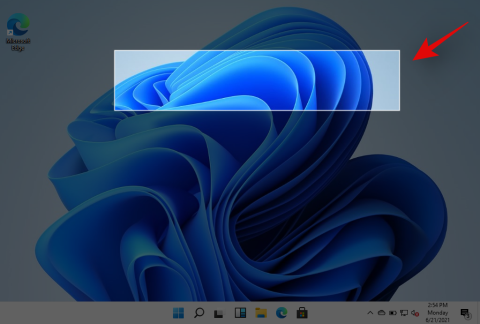
![Як відновити Windows 11 [15 способів] Як відновити Windows 11 [15 способів]](https://img2.webtech360.com/resources8/images31/image-6439-0105182722076.png)
![Як відновити Windows 11 [15 способів] Як відновити Windows 11 [15 способів]](https://img2.webtech360.com/resources8/images31/image-405-0105182722143.png)
![Як відновити Windows 11 [15 способів] Як відновити Windows 11 [15 способів]](https://img2.webtech360.com/resources8/images31/image-9440-0105182722204.png)
![Як відновити Windows 11 [15 способів] Як відновити Windows 11 [15 способів]](https://img2.webtech360.com/resources8/images31/image-9235-0105182955896.png)
![Як відновити Windows 11 [15 способів] Як відновити Windows 11 [15 способів]](https://img2.webtech360.com/resources8/images31/image-6752-0105182955965.png)
![Як відновити Windows 11 [15 способів] Як відновити Windows 11 [15 способів]](https://img2.webtech360.com/resources8/images31/image-9408-0105182722517.png)
![Як відновити Windows 11 [15 способів] Як відновити Windows 11 [15 способів]](https://img2.webtech360.com/resources8/images31/image-1959-0105182722745.png)
![Як відновити Windows 11 [15 способів] Як відновити Windows 11 [15 способів]](https://img2.webtech360.com/resources8/images31/image-3028-0105182722836.png)
![Як відновити Windows 11 [15 способів] Як відновити Windows 11 [15 способів]](https://img2.webtech360.com/resources8/images31/image-2165-0105182722899.png)
![Як відновити Windows 11 [15 способів] Як відновити Windows 11 [15 способів]](https://img2.webtech360.com/resources8/images31/image-9581-0105182722985.png)
![Як відновити Windows 11 [15 способів] Як відновити Windows 11 [15 способів]](https://img2.webtech360.com/resources8/images31/image-7098-0105182723056.png)
![Як відновити Windows 11 [15 способів] Як відновити Windows 11 [15 способів]](https://img2.webtech360.com/resources8/images31/image-1063-0105182723121.png)
![Як відновити Windows 11 [15 способів] Як відновити Windows 11 [15 способів]](https://img2.webtech360.com/resources8/images31/image-2132-0105182723214.png)
![Як відновити Windows 11 [15 способів] Як відновити Windows 11 [15 способів]](https://img2.webtech360.com/resources8/images31/image-6753-0105182723323.png)
![Як відновити Windows 11 [15 способів] Як відновити Windows 11 [15 способів]](https://img2.webtech360.com/resources8/images31/image-2650-0105182723417.png)
![Як відновити Windows 11 [15 способів] Як відновити Windows 11 [15 способів]](https://img2.webtech360.com/resources8/images31/image-3719-0105182723520.png)
![Як відновити Windows 11 [15 способів] Як відновити Windows 11 [15 способів]](https://img2.webtech360.com/resources8/images31/image-7789-0105182723725.png)
![Як відновити Windows 11 [15 способів] Як відновити Windows 11 [15 способів]](https://img2.webtech360.com/resources8/images31/image-2823-0105182723892.png)
![Як відновити Windows 11 [15 способів] Як відновити Windows 11 [15 способів]](https://img2.webtech360.com/resources8/images31/image-7821-0105182956057.png)
![Як відновити Windows 11 [15 способів] Як відновити Windows 11 [15 способів]](https://img2.webtech360.com/resources8/images31/image-7756-0105182724049.png)
![Як відновити Windows 11 [15 способів] Як відновити Windows 11 [15 способів]](https://img2.webtech360.com/resources8/images31/image-6893-0105182724113.png)
![Як відновити Windows 11 [15 способів] Як відновити Windows 11 [15 способів]](https://img2.webtech360.com/resources8/images31/image-8890-0105182956148.png)
![Як відновити Windows 11 [15 способів] Як відновити Windows 11 [15 способів]](https://img2.webtech360.com/resources8/images31/image-4377-0105182724504.png)
![Як відновити Windows 11 [15 способів] Як відновити Windows 11 [15 способів]](https://img2.webtech360.com/resources8/images31/image-5446-0105182724592.png)
![Як відновити Windows 11 [15 способів] Як відновити Windows 11 [15 способів]](https://img2.webtech360.com/resources8/images31/image-5068-0105182725172.png)
![Як відновити Windows 11 [15 способів] Як відновити Windows 11 [15 способів]](https://img2.webtech360.com/resources8/images31/image-9689-0105182725280.png)
![Як відновити Windows 11 [15 способів] Як відновити Windows 11 [15 способів]](https://img2.webtech360.com/resources8/images31/image-3654-0105182725335.png)
![Як відновити Windows 11 [15 способів] Як відновити Windows 11 [15 способів]](https://img2.webtech360.com/resources8/images31/image-7724-0105182725565.png)
![Як відновити Windows 11 [15 способів] Як відновити Windows 11 [15 способів]](https://img2.webtech360.com/resources8/images31/image-9311-0105182725854.png)
![Як відновити Windows 11 [15 способів] Як відновити Windows 11 [15 способів]](https://img2.webtech360.com/resources8/images31/image-3277-0105182725914.png)
![Як відновити Windows 11 [15 способів] Як відновити Windows 11 [15 способів]](https://img2.webtech360.com/resources8/images31/image-794-0105182726004.png)
![Як відновити Windows 11 [15 способів] Як відновити Windows 11 [15 способів]](https://img2.webtech360.com/resources8/images31/image-5932-0105182726311.jpg)
![Як відновити Windows 11 [15 способів] Як відновити Windows 11 [15 способів]](https://img2.webtech360.com/resources8/images31/image-5382-0105182726417.jpg)
![Як відновити Windows 11 [15 способів] Як відновити Windows 11 [15 способів]](https://img2.webtech360.com/resources8/images31/image-4518-0105182726486.jpg)
![Як відновити Windows 11 [15 способів] Як відновити Windows 11 [15 способів]](https://img2.webtech360.com/resources8/images31/image-7519-0105182726601.png)
![Як відновити Windows 11 [15 способів] Як відновити Windows 11 [15 способів]](https://img2.webtech360.com/resources8/images31/image-6969-0105182726712.png)
![Як відновити Windows 11 [15 способів] Як відновити Windows 11 [15 способів]](https://img2.webtech360.com/resources8/images31/image-4486-0105182726796.png)
![Як відновити Windows 11 [15 способів] Як відновити Windows 11 [15 способів]](https://img2.webtech360.com/resources8/images31/image-3622-0105182726853.png)
![Як відновити Windows 11 [15 способів] Як відновити Windows 11 [15 способів]](https://img2.webtech360.com/resources8/images31/image-4691-0105182726957.png)
![Як відновити Windows 11 [15 способів] Як відновити Windows 11 [15 способів]](https://img2.webtech360.com/resources8/images31/image-4141-0105182727056.png)
![Як відновити Windows 11 [15 способів] Як відновити Windows 11 [15 способів]](https://img2.webtech360.com/resources8/images31/image-7142-0105182727192.png)
![Як відновити Windows 11 [15 способів] Як відновити Windows 11 [15 способів]](https://img2.webtech360.com/resources8/images31/image-4659-0105182727255.png)
![Як відновити Windows 11 [15 способів] Як відновити Windows 11 [15 способів]](https://img2.webtech360.com/resources8/images31/image-5728-0105182727364.png)
![Як відновити Windows 11 [15 способів] Як відновити Windows 11 [15 способів]](https://img2.webtech360.com/resources8/images31/image-5177-0105182727469.png)
![Як відновити Windows 11 [15 способів] Як відновити Windows 11 [15 способів]](https://img2.webtech360.com/resources8/images31/image-6246-0105182727564.png)
![Як відновити Windows 11 [15 способів] Як відновити Windows 11 [15 способів]](https://img2.webtech360.com/resources8/images31/image-5695-0105182727667.png)
![Як відновити Windows 11 [15 способів] Як відновити Windows 11 [15 способів]](https://img2.webtech360.com/resources8/images31/image-3418-0105182727905.png)
![Як відновити Windows 11 [15 способів] Як відновити Windows 11 [15 способів]](https://img2.webtech360.com/resources8/images31/image-2867-0105182728010.png)
![Як відновити Windows 11 [15 способів] Як відновити Windows 11 [15 способів]](https://img2.webtech360.com/resources8/images31/image-2316-0105182728120.png)
![Як відновити Windows 11 [15 способів] Як відновити Windows 11 [15 способів]](https://img2.webtech360.com/resources8/images31/image-902-0105182728296.png)
![Як відновити Windows 11 [15 способів] Як відновити Windows 11 [15 способів]](https://img2.webtech360.com/resources8/images31/image-3903-0105182728416.png)
![Як відновити Windows 11 [15 способів] Як відновити Windows 11 [15 способів]](https://img2.webtech360.com/resources8/images31/image-1420-0105182728498.png)
![Як відновити Windows 11 [15 способів] Як відновити Windows 11 [15 способів]](https://img2.webtech360.com/resources8/images31/image-2489-0105182728594.png)
![Як відновити Windows 11 [15 способів] Як відновити Windows 11 [15 способів]](https://img2.webtech360.com/resources8/images31/image-3558-0105182728684.png)
![Як відновити Windows 11 [15 способів] Як відновити Windows 11 [15 способів]](https://img2.webtech360.com/resources8/images31/image-7422-0105182728754.png)
![Як відновити Windows 11 [15 способів] Як відновити Windows 11 [15 способів]](https://img2.webtech360.com/resources8/images31/image-212-0105182728819.png)
![Як відновити Windows 11 [15 способів] Як відновити Windows 11 [15 способів]](https://img2.webtech360.com/resources8/images31/image-3525-0105182728991.png)
![Як відновити Windows 11 [15 способів] Як відновити Windows 11 [15 способів]](https://img2.webtech360.com/resources8/images31/image-4594-0105182729090.png)
![Як відновити Windows 11 [15 способів] Як відновити Windows 11 [15 способів]](https://img2.webtech360.com/resources8/images31/image-9527-0105182729253.png)
![Як відновити Windows 11 [15 способів] Як відновити Windows 11 [15 способів]](https://img2.webtech360.com/resources8/images31/image-4249-0105182729349.png)
![Як відновити Windows 11 [15 способів] Як відновити Windows 11 [15 способів]](https://img2.webtech360.com/resources8/images31/image-2835-0105182729531.png)


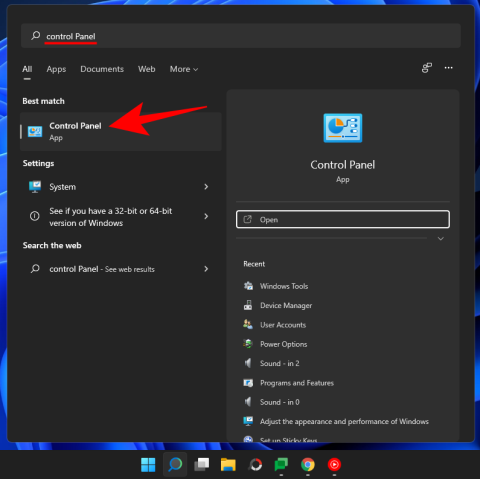










![Як вводити акценти в Windows 11 [6 способів] Як вводити акценти в Windows 11 [6 способів]](https://blog.webtech360.com/resources8/images31/image-285-0105182715408.png)





